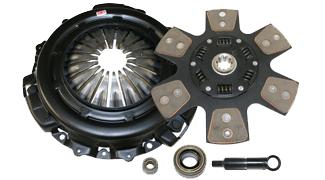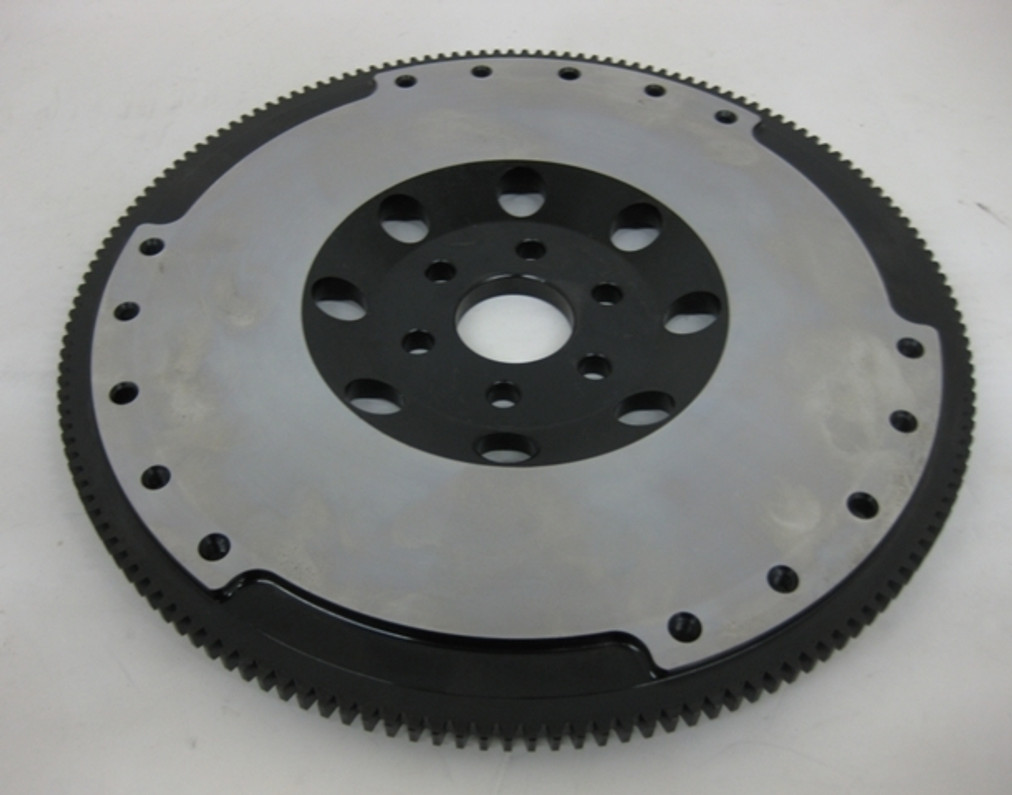Drivetrain Upgrades
Drivetrain Upgrades
Your Mustang's engine can be making more power than a top fuel
dragster, but it won't do any good if you can't transfer that power to the
transmission. By making the right upgrades to the clutch, flywheel and
surrounding parts, you can get reliable launches while keeping drivability
impact to a minimum.
How a Clutch Works
A clutch shares a lot of design similarities with a disc brake. The flywheel,
which is connected to the crankshaft, has a flat metal surface, while the
clutch disc is covered in friction material similar to what is found on brake
pads. When the two meet, they should lock against each other. However, instead
of halting the vehicle, the connection between the clutch and flywheel
transfers power between the engine and the transmission.
The clutch is pushed against the flywheel by the pressure plate, which is
pushed down by the diaphragm spring. The diaphragm spring uses fingers made of
spring steel which meet up with the throwout bearing.
Stock vs. Performance Clutches

The stock design is made for easy driving and can't handle much more than the
stock engine output. Racing clutches are built for extreme temperatures and
massive torque loads, but are hard to engage and can chatter at low RPM. Street
performance clutches strike a balance, providing plenty of room for increased
power while still being easy to engage so they can be driven around town. Each
component of the assembly is altered to get the right characteristics for
clutch engagement and performance:
Making the diaphragm spring stronger, increasing clamping force. This helps
keep the clutch from sliding against the flywheel, but it also increases clutch
pedal effort.
Performance clutches use materials including brass and ceramic formulations
that can withstand more heat and higher friction loads for harder launches and
faster shifts encountered on the track.
The area of the clutch face will be smaller. By reducing the contact area, the
clamping force can be concentrated into a smaller space, increasing the
pressure between the clutch pads and flywheel. Some performance materials need
high amounts of clamping force to be effective.
To see the difference, just look at the CCI Stage 1 and Stage 5 clutches: the
street-focused Stage 1 uses a stock design with improved materials, while the
Stage 5 has a sprung center to dissipate vibration and 6 small clutch faces for
high pressure engagement.
Flywheels
The flywheel is both a drivetrain component and an engine component. The
inertia of the flywheel stores energy from each ignition stroke to keep the
crankshaft spinning long enough to get to the next ignition. Switching to a
lighter flywheel reduces inertia for faster revving but makes the engine run
rougher.
On the drivetrain side, it's the contact point with the clutch. Like a brake
rotor, it needs a smooth, flat surface to get maximum contact with the clutch
material. If you're reusing the flywheel when replacing the clutch, it needs to
be machined.
How Many Splines Does the Clutch Need to
Fit?
The clutch you use needs to be able to fit the splined input shaft of your
Mustang's transmission. The number of splines on that shaft will depend on
which transmission you're using:
The stock Tremec/Borg Warner T5, T45, TR-3650 and T56 use a 10-spline input
shaft. That includes every 5-speed used in the Mustang as well as the 6-speed
found in 2003 and 2004 Cobras. This shaft is a common point of failure on these
transmissions, so most rebuilt or replacement units with any performance
intentions are fitted with a 26 spline input shaft, including Ford Racing's own
Tremec T5 Extra HD.
The Tremec TR-6060 used in the Shelby GT500s built from 2007 to 2014 use a 26
spline input shaft.
The Getrag MT82 6 speed used on 2011 and later Mustangs has a 23-spline input
shaft.
Clutch Break In
To get the clutch properly broken in, the car needs to be driven about 500
miles in town. The constant stops and starts combined with the low power load
causes the right temperature fluctuations to knock off any high spots on the
clutch surface and embed clutch material into the flywheel. Installing a clutch
in your car and immediately using it for launches can cause the clutch surface
to glaze over, reducing friction and maximum torque capacity. If that happens,
the only way to fix the problem is by installing a new clutch plate.
Get the Parts You Need to Put Down Power
Anderson Ford Motorsport doesn't just sell
performance Mustang
parts
, we
test them and use them to help our customers build cars that meet their
performance goals, so we know what works. We offer everything you need to keep
your engine and transmission connected whether you're doing some mild upgrades
or building a drag monster.
Recent Posts
-
Bringing the Fox Body Mustang into the 21st Century with Holley Terminator X
Anderson Ford Motorsport has been in the Fox Mustang performance industry since 1989. One of the bi …22nd Oct 2021 -
Roush Supercharger install on a 2019 Ford Mustang
Check out this 2019 Ford Mustang before and after we installed a Roush Supercharger. …21st Feb 2020 -
All Blower Installations are not Equal.
Why Should You Choose a Company to Install Your Blower That Has a Dyno Facility In-House?Are all de …24th Jan 2020


